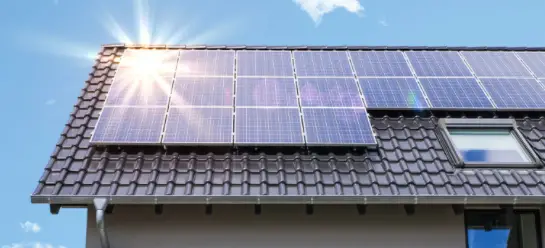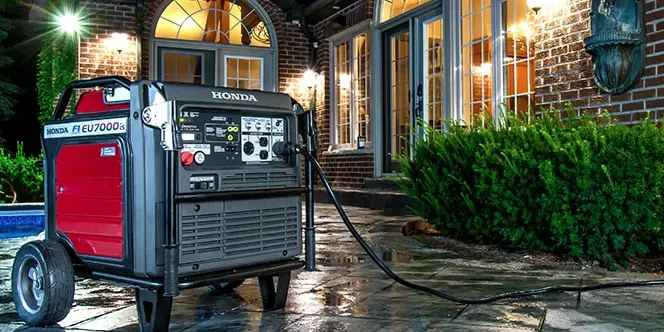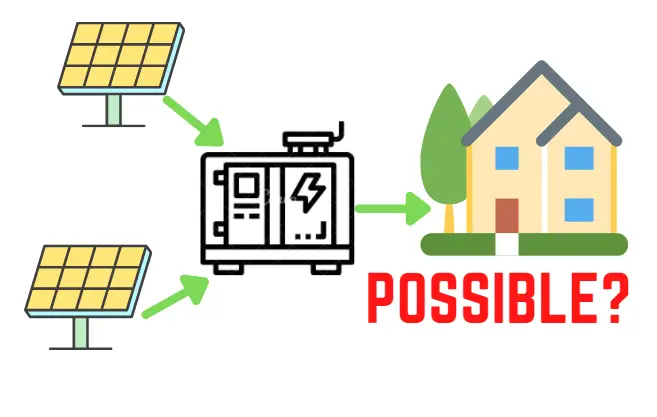Can a solar generator power a whole house?
The short answer is YES, if the solar system is set up properly with all of the needed components.
There are other factors such as components, builds, and budgets that go into play, but it is possible and- sometimes- easy to have solar generators power a whole house to be completely powered by off-grid solar power and save money.
In this article, let's break down everything you need to know and detail some equipment you'll need for your DIY solar system setup.
How Much Electrical Power Do I Need To Power My House?

Knowing how much electrical power you’ll need to power your entire house is a vital part of the process, but it’s often hard to determine the true amount of power you’ll need to power your house.
The average annual electricity consumption for a U.S. residential utility customer was 11000 kilowatthours (kWh)
- An average of about 900 kWh per month.
- Louisiana had the highest annual electricity consumption at 14,787 kWh per residential user
- Hawaii had the lowest at 6,296 kWh per residential customer.
What is a kiloWatt-hour? KWh is a way to measure the amount of electricity used in an hour. It is simply a unit of measurement that equals the amount of energy you would use if you kept a 1,000 watt appliance running for an hour.
If a 300 Watt solar panel has been in direct sunlight for 3 hours, you now have 900 Watt-hours, or 0.9 kiloWatt-hours, of energy in your system.
Simple Conversion Math - 1000 W = 1 KW (Conversion factor of 1000)
According to EIA, a typical house consumed about ~30 kiloWatt-hours of energy every day in 2019 on average. Even though we have overshot the amount of approximate energy needed by 40%, it’s always better to have more than less since you’ll have cloudy days, rainy weeks, and the nighttime to take into consideration.
When Is It Appropriate To Use Solar Generators To Power A Whole House?

There’s many situations where it’s better and more beneficial to use solar power to power your entire house, but in some situations, it can end up costing you more than you would’ve spent on electricity bills.
PROS
A big advantage in powering your whole house with solar power is if you live in a region in the world where sunshine is common and abundant.

If you live in Arizona or Egypt, for example, you’re at a great advantage for solar energy since those places experience more than 4,000 hours of sunlight annually—it’s great for solar panels to be under direct sunlight for a prolonged time. More sunlight = more power!
Another advantage would be to use solar power to cut back on your electricity bill rather than eliminating the city’s electrical grid from being a part of your house completely. Some people use just a few solar panels to power small appliances like a television, chargers, the internet router, and maybe a gaming console.
This allows them to cut back on a lot of money on their electric bill every month which adds up overtime. Then, by reinvesting all of the saved money, they buy more solar panels and slowly become fully dependent on solar power to run their house, little by little every time.
CONS

If you live in a region of the world where sunlight isn’t as abundant in the area you live in, you may be losing money by going completely solar. I’m talking about places like Norway and Alaska where they get a month of sunlight out of the entire year, or they experience 6 months of pure darkness due to their geographical location—not a great environment for a solar panel.
Another possible big disadvantage for powering your house with solar power would be that some people take shortcuts and buy cheaper components and kits to power their house. Don’t get me wrong; this might work, but you’ll either be missing out on a lot of energy due to the poor quality of solar panels or batteries, or you may have a broken component a month into your solar project.
Lastly, since solar generators are to be used for emergency cases, it’ll take multiple solar generators and, maybe, a solar kit to power your whole house to get the job done. Though it may be expensive, it may be worth it in the long run to invest in a good solar kit.
Recommend Solar Generators For Home Use
There are many solar generators out there, in the market, but picking the best one can be difficult but not for us! Below, we have hand-picked two of the best solar generators in the market, currently. Let us know what you think!
Why did we choose this power station?
ECOFLOW’s portable power station is there for you when you’re somewhere else. By being a landmark of both design and functionality, this power station can bring you the most power, the fastest recharge, and the least amount of stress while you’re at home or away on a trip.
On average, the power station can recharge up to 80% of its battery life in one hour. With a 3300 Watt surge, that’s enough power to power a lightbulb for 28 hours, a laptop for 18 hours, or an entire toaster for 45 minutes. With more than one of these solar power stations, you can power your house or tent while saving money and going green.
What are users saying about this power station?
3300 Watt Surge- Equipped with 110V outlets, the surge allows the power station to power small things like phone chargers and camera batteries, but it also allows for powering up large, heavy-duty power tools and medium-sized appliances like computers, microwaves, and coffee machines—items that require a lot of energy due to heat.
Compatible With Any Solar Panel- ECOFLOW’s power station is compatible with any solar panel up to 400 Watts. With a perfectly perpendicular sunlight path for 4 hours, you can get 1.6 kiloWatt-hours worth of energy which is enough to power 5% of an entire house with just one solar generator in a sixth of a day. Imagine what you can do with 5 generators.
13 Devices Powered Simultaneously- With 6 AC outlets, 4 USB-A outlets, 2 USB-C outlets, and a 12V car port outlet, you can power 13 devices to this solar generator at once. For recharging, if you’re not wanting to use sunlight or you can’t, you can always power it up using the city’s grid to take the generator to your next camping trip for a few days worth of electricity.
Why did we choose this power station?
The Yeti power station is a cheaper alternative to the previous option for a power station. Although it has less power, it’s still pretty powerful if used correctly. By buying 5 of these power stations instead of one of the previous power stations, you can obtain 840 Watt-hours in just one hour of charging!
What are other users saying about this power station?
USB, AC, and 12V Outputs- With just one full charge, you can recharge a smartphone 15 times. For a smaller laptop, you can usually get about a full charge or two with a full charge of the power station, and for most DSLR cameras, you can usually squeeze out up to 8 recharges while being away from the city.
Travel-Friendly- With the power generator being the ideal shape and size for traveling, the generator fits perfectly in the backseat to keep power-hungry devices charging during long road trips, and the battery is a lead-acid battery which is safe for airline traveling.
Optional Solar Recharging- On the go? The Yeti power generator pairs with Goal Zero’s solar panels (which are sold separately from this) to recharge directly from the sun. Although it might take more time charging this power generator with solar power rather than the city’s power, it’ll be worth it in the end to have electricity anywhere the sun touches.
If you’re still wanting to find out more about the best solar generators in the market currently, check out our guide, “Best Solar Generator Guide,” for an in-depth analysis and a full breakdown of each product.
What Are Other Core Items Needed?
Most solar generators are usually found with an all-in-one deal—they’ll come with batteries, inverters, charge controllers, and sometimes, solar panels with kits. Sometimes, you’ll have to purchase these items separately, but don’t worry; we’ll take you through a short summary of what you’ll need.
BATTERY
Most solar generators come with a battery, so you won’t have to worry about purchasing a battery, but if you’re wanting more juice on-the-go, if you buy a battery, you can store unused electricity within a different battery, and switch them out once one is depleted.
If you’re wanting to know more about batteries, check out our articles about them, “5 Best Batteries for Solar RV’s,” to get to know more about solar batteries and their functionality.
INVERTER
The same deal with these, most solar generators will come with built-in inverters, to convert AC power from the sun’s rays into usable DC power. Buying and replacing an inverter is simple and cheap since bigger inverters for houses are cheap as well—they are a vital part of the process and must be treated with care.
If you’re wanting to know more about inverters and where they fall into the process of setting up a solar system, you can check out our article, “Core Solar Panel Components,” to get a full in-depth explanation of inverters and more!
CHARGE CONTROLLERS
Most solar generators won’t come with a charge controller since it’s a premium add-on, but it’s highly recommended to have one within your solar system.
In short words, charge controllers keep your battery from filling up all the way which protects the battery along with extending the battery’s life to its fullest. If you’re wanting to know some of the best solar charge controllers in the market currently, click on our article, “6 Best Solar Charge Controllers,” to find out more about their functionality and some extras.
NUMBER OF SOLAR PANELS NEEDED
The number of solar panels that you’ll need depends completely on how much you’re planning on power with them.
To power an entire house, like mentioned before, you’ll generally need around 25-35 solar panels to be completely sure that they will power the entire house and more.
The true test is to see if 25 of the 100 Watt solar panels will be enough or if you need to buy the more-expensive 300 Watt solar panels. 100 Watts may not seem like a lot, but to truly see how much power they hold, read our article, “What Can a 100 Watt Solar Panel Run?” to figure out how many solar panels you’ll need if you decide to use 100 Watt solar panels.
Common FAQs
How do I calculate how much power I need for my house?
The most accurate way to calculate how much power you’ll need for your house is to make a list of every appliance and electronics in your house that uses electricity.
On the side of each item, you can see how many Watts each item is rated at—multiply each of the item’s Wattage by the number of hours per month that you use that item.
After multiplying everything, add all of the Watt-hour values up which gives you how much power you’ll need in a month—per month, you should get a value of 900 kiloWatt-hours; if it’s less than this, that’s great.
How many solar panels do I need for my house?
Depending on your value calculated up above and depending on your budget, you’ll need a lot of solar panels. If your average energy consumption per month is less than 900 kiloWatt-hours, around 20-25 solar panels will do, depending on whether they’re 100 Watt solar panels or 300 Watt solar panels.
If the value is higher than 900 kiloWatt-hours, don’t worry! You’ll probably need to spend a little extra and buy around 30-35 solar panels for your house, but that’s in extreme situations of 5-6 person families.
What’s the average cost for a project like this?
Since an average solar panel costs around $200, and you need 25-35 solar panels usually, you can see that the bulk of your money will go towards the solar panels which will cost anywhere from $5,000 to $7,000.
Buying a good solar battery or two, inverter(s), a solar charge controller, the mounts, and the wiring, you can add another $2,000 to $3,000 to the solar panel value.
If you’re installing it yourself, be careful! But if you’re outsourcing the work, you can expect anywhere from $1,000 to $2,000 of a cost to pay to the installer.
With a total nearing $8,000 to $12,000, don’t think of the total value as too high—think of it in terms of monthly utility bills. If your average monthly electricity bill is $120 in a month, you’re looking at around 5 to 8 years before everything is paid for, and after those years are up, you can keep your electric bill money in your pockets.
In 10 years after the solar system is paid off, you can expect savings of around $14,400 which is enough to buy a brand new car in some states. With technology constantly being improved, you can expect the pay-off time to decrease and your savings to increase over the years.
What’s the difference between gas-powered generators vs. solar generators?
Gas-powered generators usually require some sort of a power supply—most people use propane tanks to support the gas-powered generators. Gas-powered generators are usually guaranteed to provide power as long as you have the fuel, and it’s the most common type of generator out there, but it might not last as long as you want it to.
Solar generators, on the other hand, don’t guarantee anything without sunlight which can be hard to obtain sometimes, especially at night! But solar generators can keep running for a long time, possibly powering an entire household if there’s enough generators, with enough sunlight.
DIY Or Outsource The Work?
If you would like to run some DIY solar system projects yourself, we encourage you to do it yourself! Though, there are some regulations and laws against installing solar panels yourself in some states. We recommend checking in with your city’s hall to make sure that you can install a solar system by yourself or if you should outsource the work.
If you decide to outsource the work, no worries! Professionals don’t charge too much over your budget, and they’ll ensure that quality work gets done. Plus, they’ll take the blame and fix any mistakes that you find later on if something decides to break down or malfunction.
If you’re wanting to choose the DIY path, let our article guide you through it! By reading “The Ultimate DIY Solar Panel Setup,” you can get an idea of what steps to take to get the perfect DIY setup for you!
Wrapping Up
Hopefully, this article helped you make some purchases on solar generators and gave you an idea of how powerful solar power can be.
A house isn’t easy to power up—you can see that every month that you have to pay the electric bill. With solar panels, that can be a thing of the past.
In the future, they predict that solar panels will be cheaper to make, making the pay-off time to be only a few years. After that, you can expect to be saving money for the rest of your life or until the 35-year warranty expires—that’s a long time for savings!
Be sure to check out our guide on how your window blinds can also provide backup solar power!



